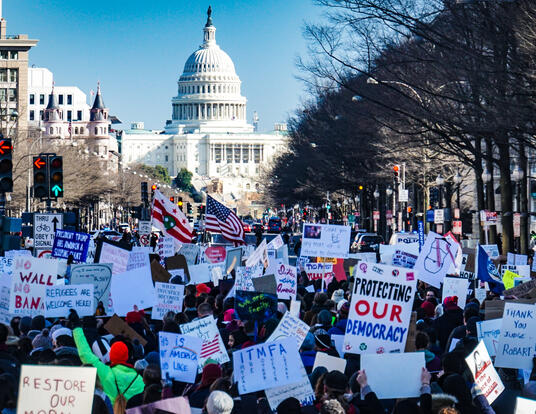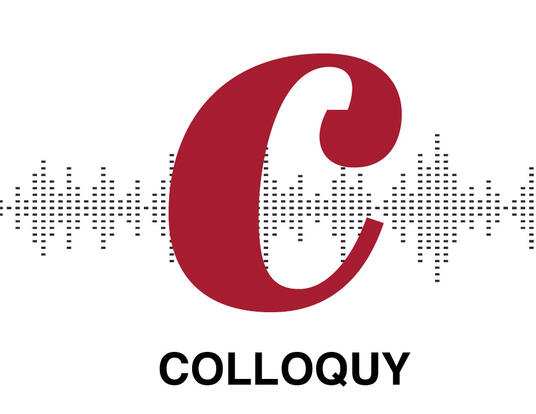Colloquy Podcast: The Incredible Shrinking Vaccine Efficacy
Mandates, declining effectiveness, and the path out of the COVID-19 pandemic
COVID-19 infections are surging again in the U.S., despite the availability of vaccines that are both safe and effective. In the inaugural episode of the GSAS Colloquy podcast, alumnus Michael Lin, a microbiologist and professor at Stanford University talks about vaccination mandates as a path out of the pandemic, but also about the decline in vaccine efficacy over time. He advocates booster shots for adults over the age of 16, as well as continued public health measures like masking indoors. Lin also speaks about ongoing work at his lab to develop a new treatment for COVID-19 that targets the virus on the molecular level.
NOTE: This interview was conducted just before Dr. Rochelle Walensky, director of the Centers for Disease Control endorsed COVID-19 booster shots for frontline workers at high risk for exposure to the virus.
I wonder if you could talk a bit about the pandemic-related work of Lin Lab. What kind of therapeutics are you developing for the treatment of COVID-19?
So, the most pandemic-related thing that we're working on are small-molecule drugs to inhibit the SARS-CoV-2 virus. So we're making a class of drugs to inhibit the protease of the virus. So, when the virus lands in a cell, one of the first things that it does is to express a protease which then clips other viral proteins to create the replication complex. And so we're targeting that protease by developing drugs.
And the hope is to develop drugs that you can take through a pill. Our main competitor in this is actually Pfizer. We started our work the month we went into shutdown. The reason we got into this was that the lab had been working on viral proteases before and using viral protease inhibitors.
And we noticed that one of the existing clinically approved protease inhibitors, which is used for treating hepatitis C, could fit and could inhibit the SARS-CoV-2 protease. It's not perfect. But it actually has considerable activity. Enough so that we decided to make modifications of that existing drug to make it a better inhibitor for SARS-CoV-2 protease.
And we've now been doing that since April 2020, for greater than a year now. We've been through several iterations of this class of drugs and every iteration improves. And so we're getting to the point where we have an orally available drug that is potent enough that we might be able to get inhibitory activity when we dose animals and, hopefully in the future, people with the drug.
In March of 2020, as the country declared a state of emergency due to the spread of COVID-19, you gave a talk to a group at MIT entitled "Coronavirus and COVID-19—the basic biology behind the epidemic". Since then, the Delta variant has become the dominant strain of the virus in the United States. What do we know now about COVID and its mutations that we didn't know then? What's still unknown?
I think what we do know, over the last year of studying it, is that the virus is primarily spread through the air. I would say early on, as we all recall, we were told to wash your hands often, don't touch your face, sanitize everything we are in contact with. That advice still doesn't hurt.
But, actually, the surprising thing is that up to now there's not been one confirmed case of contact-mediated transmission and plenty of cases of airborne transmission. So we now believe that the primary route of transmission is airborne. That makes it harder to combat, of course, because it's harder to control the air than to control what you touch.
Perhaps, what remains unknown is what the effects of vaccination will be in the long run and what the evolutionary course of this virus will be in the long run. Obviously, we've seen the virus evade vaccines through mutation of the spike domain—of the spike protein. We would expect that it might continue to do so at a fairly low rate. And so the question becomes, how often will we need new or updated vaccines?
How often will we need boosters? It could be that we need a booster every fall, somewhat like influenza. And it could be that the vaccines will need to adapt to new strains of the virus as they emerge. But the exact rates at which that will happen we're not sure yet.
The surprising thing is that up to now there's not been one confirmed case of contact-mediated transmission and plenty of cases of airborne transmission.
You were mentioning the mutation of the protein spike. Can you get into the weeds a little bit on virus mutation for those of us who aren't microbiologists?
Yes, the SARS-CoV-2 virus, as we know, it's in the family of coronaviruses. And coronaviruses are RNA viruses. And many of us have learned that RNA is lower fidelity—copying of RNA is lower fidelity than copying of DNA. And this is generally true.
But the coronaviruses have an extra trick up their sleeves. They actually proofread the RNA as they copy it. And so the SARS-2 coronaviruses actually have a lower rate of mutation than other RNA viruses, such as the virus that causes AIDS, the HIV virus.
So that's actually a fairly good thing. That's a fortunate thing. It means that, even though these viruses do mutate over time, they don't mutate quite as fast as HIV does. And so that gives therapeutics and vaccines a little bit more time to suppress viral transmission before resistance mutations occur.
For the vaccines that we take and the monoclonal antibodies that we can be injected with, the target of those therapeutics is the spike protein, the famous spike protein, which is the major extracellular protein of coronaviruses. And so, most of the neutralizing antibodies that we create for coronaviruses are created to parts of the spike protein. So, the mutations that we've seen in strains like Delta or Beta that cause immuno-evasion are within the spike protein.
Can you explain how the Pfizer and Moderna vaccines use messenger RNA, which carries a sort of blueprint for creating the proteins that cells need to function, to combat COVID?
The RNA vaccines are this fairly new format of vaccines. I think we've all heard a lot about them. Basically, all the vaccines are composed of are a strand of RNA that encodes the antigen to be targeted. What happens when you get injected with the RNA is some of your cells will take up the RNA.
And then they will express the SARS-CoV-2 spike protein. And expression of this foreign protein on the surface of your cells causes your immune system to recognize it. And then create an immune response to it, which consists of raising antibodies against the spike protein and activating T-cells that specifically recognize parts of the spike protein. And it is those T-cells and B-cells together that make up your immune response.
And I understand that the Johnson & Johnson vaccine is not an RNA vaccine, correct?
That's right.
So, when they were originally developed, we were told don't shop for a vaccine. Just get the first one that you can get. And I assume that you think that that's still—was pretty good advice. But what do we know now about differences in vaccine effectiveness, particularly over time?
Yes, I agree that the initial advice to take the first vaccine you can get was the correct advice. Obviously, we were in the middle of the winter 2021 surge, that is, January, February, March of this year. And the number of vaccines was limiting. S,o you didn't really want to wait around for another vaccine. You wanted to get the first that was available.
But we do know that there are some minor differences between the vaccines. When the J&J vaccine was first tested in its phase three clinical trial, it showed up with an efficacy against all disease of around 70%. And this was clearly different from the 95% efficacy of the Pfizer and Moderna vaccines. Its protection against hospitalization was a little bit less clear because the number of patients who were hospitalized was very small in that study. But we now know, after looking at medical records, that the hospitalization protection by the Johnson & Johnson vaccine is something around 70—in the 70s percentile. So that's actually also lower than the 90+ relative protection against hospitalization offered by the RNA vaccines. So, both for cases and for hospitalization, we see about a 20% difference in protection rates between the RNA and the Johnson & Johnson vaccine.
In terms of how their efficacy changes over time, we know, from a very detailed Oxford University study, that the RNA vaccines decay in their efficacy in preventing disease at about a rate of 10% every three months. So that means that you might start with 95% efficacy and after—that's against the original strain. Against Delta, you start with about 85% efficacy. And then, after about nine months, that would drop by 30% to about 55% efficacy. So, this is probably why the administration set up a plan initially to give boosters to everybody by around the ninth month after their vaccination.
With J&J, the history of your vaccine efficacy over time is less clear. It hasn't really been followed up in any major big study. There have been some small studies looking at antibody levels over time. And those studies show that the antibody levels actually seem quite stable with J&J. That is, there haven't seemed to be any changes in the antibody levels over six months. So that's good news. So, it does seem like the vaccines operate a little bit differently, that is, J&J versus the RNA vaccines.
However, we have to keep in mind that the protection level of J&J, to begin with, is only about 70% versus Delta hospitalizations. And, in the most recent epidemiology data, the efficacy of the vaccine against Delta cases—all cases—seems to be only about 50%. So, that is, the J&J vaccine seems to start against Delta at about 50%, which is where the RNA vaccines will end up after about nine months.
The J&J vaccine seems to start against Delta at about 50 percent, which is where the RNA vaccines will end up after about nine months.
As I'm sure you know, we had a pretty notorious cluster of cases in Provincetown on Cape Cod in Massachusetts. And many of those folks had been vaccinated, which created big headlines and a lot of fear and, I think, misunderstanding. Can you talk about the incidence of breakthrough infections among people who've been fully vaccinated? How concerned should we be about that?
How concerned we should be really depends on each person's situation. But, from a public health perspective, it is concerning as long as there are segments of the population that are not well-protected. So the Provincetown case—outbreak was not a surprise for anybody who had been following news on the Delta variant and its resistance to vaccines.
So, first of all, even before the Delta variants, we knew again that the RNA vaccines seem to have 95% protection against cases at their peak efficacy whereas the J&J vaccine had about 66% to 72% protection against cases at its peak efficacy. And that was before Delta. So, even before Delta, you might expect in a crowd of people where there—if there's one person who's contagious, that some vaccinated people will get sick.
Now, it's important to keep in mind that the protection is relative to unvaccinated people. If you're RNA-vaccinated and you had 95% protection, that means you have 5% the risk of somebody who's not vaccinated in the same situation as you. But, of course, your probability of getting sick really depends on the situation.
If you are confined in a closed room with somebody who was very contagious, your probability of getting sick if you're unvaccinated is probably close to 100%. And so then if you're—but if you're vaccinated, it's not necessarily 5% either. It could be greater than that because the amount of virus that you might be exposed to could be enough to overcome the antibody defenses that your vaccine had created.
So, it's really no surprise that you would see some breakthrough cases, even before Delta. One thing to keep in mind is that—at least one thing that I like to emphasize—is that, when the clinical trials were performed, one, they were performed with variants before Delta. But, second, they were performed in the middle of rather strict lockdown procedures. And so the average challenge dose that people during the trial experienced is certainly, in some cases, much lower than the doses that you would get in public in some situations, such as going to a restaurant where people are talking loudly or going to a nightclub, et cetera.
An FDA advisory panel recently recommended booster shots only for people who are 65 or older or at high risk of severe COVID-19 and who received their second dose of the initial vaccine at least six months ago. Should booster shots be more widespread?
Yes, that's the big news this week, the FDA advisory panel who was asked to consider, who should be getting vaccine boosters at this time? And, by the way, the questions that were asked only apply to people who previously received the Pfizer vaccine. The epidemiology data that I cited, for example, from Oxford University are very clear that, in the overall population across all ages, there is waning immunity. And that means there will be higher rates of breakthrough cases, which means higher transmission to people who are not vaccinated or people who cannot mount a vigorous immune response.
So, that would be children under 12, immunocompromised people, elderly people, again, for whom even a booster might not provide adequate protection. And so I think we're going to have to revisit this question again. And, in fact, Dr. Fauci and Dr. Collins admitted as such over the weekend on various news shows. They said they fully expect that increasing breakthrough cases will require us to revisit the role of boosters for everybody over 16 at some point.
In the overall population across all ages, there is waning immunity. And that means there will be higher rates of breakthrough cases, which means higher transmission to people who are not vaccinated or people who cannot mount a vigorous immune response.
I work at Harvard University where we have very high rates of vaccination, where there's a vigorous communications effort around staying healthy and staying safe. I can only imagine what it's like being just out in the general public. I think the expectations even for people who were enthusiastic about getting inoculated were that you get inoculated, and then you're all done. Do you think that those expectations and those perceptions are a function of a failure in public health communication? Or is it simply that we weren't listening to what the public health officials and the scientists were trying to tell us?
I think people were listening. And so I think it's the other explanation to be honest. And it's unfortunate. But I believe that our public health agencies have communicated an overly simplistic view of the vaccines.
Public health has a difficult job. It has to convince people to change their behavior or go seek out a vaccine. It's easy for us at universities to find information to learn about biology, learn about the disease. And, to us, the benefits of the vaccine are obvious.
To the public at large, there are large segments that don't really understand and will either, they'll tend to follow the authorities' advice or will tend to oppose it. And so, in this unfortunately polarized environment, public health officials have to select a message that they think would be most effective in driving, in reaching their goals, in this case, vaccine uptake. So CDC has been consistently positive about the benefits of the vaccines and has tried not to discuss things like breakthrough cases.
For people who are able to acquire information on their own, it does seem confusing. If CDC is saying that vaccines protect against transmission or that breakthrough cases are very rare but then you hear in the news or on Twitter or from people like myself that breakthrough cases are actually 50% in the case of J&J compared to a non-vaccinated person, which doesn't seem rare at all, then you might get confused.
So, I'm not sure what the best response is to this. It could be that the people who are able to find information are already vaccinated and so what the CDC is trying to reach with their messaging is the small sliver of the population that can be persuaded by a simple message that vaccines work.
But, actually, I think by this time everyone who can be persuaded has been persuaded. And the next challenge is to get people behind boosters when they're needed and mitigation efforts like masking indoors, which, at this point, can be very useful, as useful as expanding the vaccination rate. We hit a wall in terms of how many people are willing to be vaccinated. And so it seems like, as we go into the winter, we have to deal with the cards that we have been dealt. We have to figure out how to best mitigate the upcoming fall and winter wave with the resources that we have.
What do you think we're heading into this fall and winter? What are we looking at when we get into the really cold weather and folks across the country are headed inside more and more and more?
I think that it really depends on the location. It depends in large part on the vaccination and previous infection rates of the community where we live. In some states like Florida, it's estimated that they probably have already reached herd immunity through a combination of vaccines and natural infection.
So a recent study pegged the rate of infection in the US population as something like 30%. It varies from 20% to 40% depending on the state. That's a very high level. On top of that, nationwide, about 50% to 60% of people are fully vaccinated. And about 70% have received at least one injection. So that plus the 30% who have been naturally infected—they don't add linearly because 30% of vaccinated people are probably also naturally infected. But, anyway, those two numbers together, multiplied together, give you probably around 80% to 90% of the population with some form of previous immunity. So, in places where more people have—the combination of vaccination and infection is really high, for example, Florida, we may not see another bump in the fall and winter. If there is a bump, it may be relatively small.
Ironically, in places that have controlled the epidemic better, for example, some of the northern states, we may actually see a bump in the fall because, while 60% or 70% of people may be fully vaccinated in those states, the remaining 30% or 40%, not all of them would've been naturally infected either. So, we may then see a bump in the fall and winter as people go indoors and become more confined.
How do we get out of this mess? Even the 1918 influenza pandemic ended at some point. How do you see this ending and us getting back to more normal living? Or is this the new normal?
The comparison to flu is quite fitting because I think the endpoint is going to be a situation very much like the flu. So, one way to frame the question is we know that the infection fatality rate for COVID-19 across all ages is around 1%. The infection fatality rate across all ages for the flu is about 0.05% to 0.1%, so 10- to 20-fold less lethal. And regular flu—regular waves of the flu also tend to affect older people, not younger people, very similar to COVID-19.
So, one way to think of the question is that if we could decrease the rate of death from COVID-19 to about 5% of the unvaccinated rate, then we would be in a situation numerically that's similar to the flu. And I think that is achievable. So, first of all, if everyone got vaccinated, you're already there. If everyone got vaccinated, then the protection from death by COVID-19 is greater than 90%. So, we would already be looking at flu-like numbers for deaths and perhaps for hospitalizations.
And then, as we know, younger people who pick up COVID-19 tend to have very mild courses and sometimes asymptomatic courses. And, just today, Pfizer announced that their vaccine, one-third dose of their vaccine seems to be safe and to elicit neutralizing antibodies in children above five. So, we can imagine a situation where children above 5 and maybe eventually also younger than that are vaccinated. And so, then you might receive vaccination when you're five, you might receive annual boosters once you're 12, similar to how people receive flu boosters.
Those vaccines might be modified once every couple of years for the latest mix of strains. And then you would see COVID-19 act somewhat like the flu. You would have 50,000 to 100,000 deaths a year in the US from COVID-19, mostly in immunocompromised and, unfortunately, elderly people.
But these are similar populations that we see tend to die from the flu each year. So that's an endpoint that we can imagine. And we just have to get—we have to get there through vaccination and, in the short term, mitigation measures.
And, of course, there are also new therapies like the one you're working on in your lab. How long before they're available to the population at large?
Right, so the Pfizer drug is already in phase 3 trials. And that drug is so closely related to ours that we just had to change two atoms to turn our drug into theirs. And so we have actually tested their drug. We had it synthesized and had it tested and compared it to ours. It's a pretty good drug. And so I'm hopeful that the Pfizer drug will succeed and will provide an option for people with breakthrough infections, especially elderly or immunocompromised people who might be at risk of hospitalization from a breakthrough infection.
So, we might see the results, I would say, as soon as a few months from now. Pfizer, when it wants to do something, can do it very quickly as we've seen. Our own drug, we're still working on it. I would say we need to improve certain pharmacological aspects of it. But we're hopeful that we can make a drug that will be, in some ways, better than the Pfizer drug.

The Colloquy podcast is a conversation with scholars and thinkers from Harvard's PhD community on some of the most pressing challenges of our time—from global health to climate change, growth and development, the future of AI, and many others.
About the Show
Produced by GSAS Communications in collaboration with Harvard's Media Production Center, the Colloquy podcast continues and adds to the conversations found in Colloquy magazine. New episodes drop each month during the fall and spring terms.
Talk to Us
Have a comment or suggestion for a future episode of Colloquy? Drop us a line at gsaspod@fas.harvard.edu. And if you enjoy the program, please be sure to rate it on your preferred podcast platform so that others may find it as well.
Get the Latest Updates
Join Our Newsletter
Subscribe to Colloquy Podcast
Simplecast Stitcher





